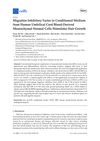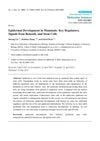Search
for
Did you mean Platelet Derived Growth Factor BB?
Learn
5 / 7 resultslearn Thymosin Beta 4
learn Epidermal Growth Factor
learn Platelet-Rich Plasma
growth factors taken from your blood and injected into your scalp to stimulate hair
learn Redensyl
commercial product with a blend of mostly natural ingredients for hair regrowth
Research
5 / 1000+ resultsresearch Human Hair Follicle Stem Cell Differentiation Into Contractile Smooth Muscle Cells Is Induced by Transforming Growth Factor-β1 and Platelet-Derived Growth Factor BB
Human hair follicle stem cells can become smooth muscle cells using specific growth factors.
research Efficacy of Autologous Platelet-Rich Plasma Alone or in Combination with a Lotion Containing Growth-Factor Like Polypeptides and Taurine in the Treatment of Androgenic Alopecia: A Randomized, Prospective, Assessor-Blinded Trial
Combining PRP with a special lotion is more effective for hair loss than PRP alone.

research Migration Inhibitory Factor in Conditioned Medium from Human Umbilical Cord Blood-Derived Mesenchymal Stromal Cells Stimulates Hair Growth
Substance from human umbilical cord blood cells promotes hair growth.
research Fibroblasts: Origins, Definitions, and Functions in Health and Disease
Fibroblasts are crucial for tissue repair and inflammation, and understanding them can help treat fibrotic diseases.

research Epidermal Development in Mammals: Key Regulators, Signals from Beneath, and Stem Cells
Skin development in mammals is controlled by key proteins and signals from underlying cells, involving stem cells for maintenance and repair.
Community Join
5 / 106 resultscommunity Growth factors, VEGF, And more,possible permanent cure for people with moderate hairloss?
The user discusses using dutasteride to stop hair loss and bimatoprost for regrowth. They plan to use VEGF with hydrogels for potentially permanent hair follicle improvement and suggest PRP as an alternative.
community Comprehensive Microneedling Guide
Microneedling for hair restoration involves daily use of a 0.3 mm device and weekly use of a 0.5 mm device. Combining microneedling with Minoxidil can enhance hair growth.
community 1 month on minoxidil - progress pictures
The user has been using finasteride for years and recently started using minoxidil foam, noticing some increased hair density and vellus hairs after one month. They report no scalp issues or side effects and also use a ketoconazole shampoo weekly.
community Do you keep gains if you stop microneedling?
Stopping microneedling may result in losing hair gains, as it enhances the effectiveness of treatments like minoxidil. Combining microneedling with minoxidil and finasteride is more effective than using microneedling alone.
community New and Interesting HairLoss Studies/Papers/Reviews
Hair loss treatments discussed include Dutasteride with Ketoconazole, tissue engineering strategies, and androgenetic alopecia therapies. Massage doubles follicular retention, improving treatment effectiveness.